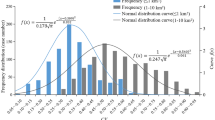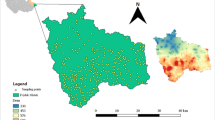Abstract
In order for soil resources to be sustainably managed, it is necessary to have reliable, valid data on the spatial distribution of their environmental impact. However, in practice, one often has to cope with spatial interpolation achieved from few data that show a skewed distribution and uncertain information about soil contamination. We present a case study with 76 soil samples taken from a site of 15 square km in order to assess the usability of information gleaned from sparse data. The soil was contaminated with cadmium predominantly as a result of airborne emissions from a metal smelter. The spatial interpolation applies lognormal anisotropic kriging and conditional simulation for log-transformed data. The uncertainty of cadmium concentration acquired through data sampling, sample preparation, analytical measurement, and interpolation is factor 2 within 68.3 % confidence. Uncertainty predominantly results from the spatial interpolation necessitated by low sampling density and spatial heterogeneity. The interpolation data are shown in maps presenting likelihoods of exceeding threshold values as a result of a lognormal probability distribution. Although the results are not deterministic, this procedure yields a quantified and transparent estimation of the contamination, which can be used to delineate areas for soil improvement, remediation, or restricted area use, based on the decision-makers’ probability safety requirement.








Similar content being viewed by others
References
InstitutionalAuthorNameAnalytical Methods Committee (1995) ArticleTitleUncertainty of measurement: implications of its use in analytical science. Analyst 120 2303–2308
M. Armstrong (1998) Basic linear geostatistics. Springer Berlin 146
N. Barabas P. Goovaerts P. Adriaens (2001) ArticleTitleGeostatistical assessment and validation of uncertainty for three-dimensional dioxin data from sediments in an estuarine river. Environmental Science and Technology 35 3294–3301 Occurrence Handle10.1021/es010568n Occurrence Handle1:CAS:528:DC%2BD3MXltVCmtL8%3D Occurrence Handle11529567
J. Bouma (2002) ArticleTitleLand quality indicators of sustainable land management across scales. Agriculture, Ecosystems and Environment 88 IssueID2 129–136
J. Bouma H. W. G. Booltink A. Stein (1996) ArticleTitleReliability of soil data and risk assessment of data applications. Soil Science Society of America Special Publication 47 677
N. A. C. Cressie (1993) Statistics for spatial data. John Wiley New York 900
A. Desaules J. Sprengart G. Wagner H. Muntau S. Theocharopoulos (2001) ArticleTitleDescription of the test area and reference sampling at Dornach. The Science of the Total Environment 264 17–26 Occurrence Handle10.1016/S0048-9697(00)00609-4 Occurrence Handle1:CAS:528:DC%2BD3MXhsFejtrs%3D Occurrence Handle11213180
C. V. Deutsch A. G. Journel (1998) GSLIB Geostatistical software library and user’s guide. . New York 369
J.-P. Dubois R. Schulin (1993) Sampling and analytical techniques as limiting factors in soil monitoring. R. Schulin A. Desaules R. Webster B. von Steiger (Eds) Soil monitoring—early detection and surveying of soil contamination and degradation. Birkhäuser Basel 271–273
W. Fresenius A. Kettrup R. W. Scholz (1995) ArticleTitleGrössenordnung Faktor 2: Zur Genauigkeit von Messungen bei Altlasten. Altlasten Spektrum 4 217–218
Geiger G., and R. Schulin (1995) Risikoanalyse, Sanierungs- und Überwachungsvorschläge für das schwermetallbelastete Gebiet von Dornach. Berichte 2. Volkswirtschaftsdepartement des Kantons Solothurn, Amt für Umweltschutz, Solothurn, 79 pp
Geovariances. (1997) Isatis. Geostatistical software. Version 3.1.2. Avon
P. Goovaerts (1997) Geostatistics for natural resources evaluation. Oxford University Press New York 483
P. Goovaerts (2000) ArticleTitleEstimation or simulation of soil properties? An optimization problem with conflicting criteria. Geoderma 97 165–186 Occurrence Handle10.1016/S0016-7061(00)00037-9
P. Goovaerts (2001) ArticleTitleGeostatistical modelling of uncertainty in soil science. Geoderma 103 3–26 Occurrence Handle10.1016/S0016-7061(01)00067-2
P. Goovaerts V. Meirvenne (2001) Delineation of harzard areas and additional sampling strategy in prescence of a location specific threshold. A. Soares J. Gomez-Hernandez J. Froidevaus (Eds) geoENVIII—geostatistics for environmental applications. Kluwer Academic Publishers Dordrecht 125–136
P. Goovaerts R. Webster J.-P. Dubois (1997) ArticleTitleAssessing the risk of soil contamination in the Swiss Jura using indicator geostatistics. Environmental and Ecological Statistics 4 31–48 Occurrence Handle10.1023/A:1018505924603
C. A. Gotway (1994) ArticleTitleThe use of conditional simulation in nuclear-waste-site performance assessment. Technometrics 36 129–140
Gotway C. A., B. M. Rutherford (1993) Stochastic simulation for imaging spatial uncertainty: comparison and evaluation of available algorithms. Pages 1–21 in Geostatistical Simulations. Fontainebleau, France.
K. Grunewald (1997) Grossräumige Bodenkontamination. Springer Berlin 250
Gysi C., S., Gupta W., Jäggi J. -A. Neyroud (1991) Wegleitung zur Beurteilung der Bodenfruchtbarkeit. Eidgenössische Forschungsanstalt für Agrikulturchemie und Umwelthygiene, Liebefeld-Bern, 89 pp
C. Hendriks R. Obernosterer D. Muller S. Kytzia P. Baccini P. H. Brunner (2000) ArticleTitleMaterial flow analysis. Case studies on the city of Vienna and the Swiss lowlands. Local Environment 5 311–328 Occurrence Handle10.1080/13549830050134257
S. Hesske M. Schärli O. Tietje R. W. Scholz (1998) Zum Umgang mit Schwermetallen im Boden: Falldossier Dornach. Pabst Science Publishers Lengerich 145
A. G. Journel (1974) ArticleTitleGeostatistics for Conditional Simulation of Ore Bodies. Economic Geology 69 673–68
Journel A. G. (1989) Fundamentals of geostatistics in five lessons. American Geophysical Union, Washington, DC, 40 pp
A. G. Journel C. J. Huijbregts (1978) Mining geostatistics. Academic Press London 599
A. Keller B. von Steiger S. E. A. T. M. van der Zee R. Schulin (2001) ArticleTitleA stochastic empirical model for regional heavy-metal balances in agroecosystems. Journal of Environmental Quality 30 1976–1989 Occurrence Handle1:CAS:528:DC%2BD38Xht1SlsLk%3D Occurrence Handle11790004
A. Keller K. Abbaspour R. Schulin (2002) ArticleTitleAssessment of uncertainty and risk in modeling regional heavy metal accumulation in agricultural soils. Journal of Environmental Quality 31 175–187 Occurrence Handle1:CAS:528:DC%2BD38XlvVCgu70%3D Occurrence Handle11837421
E. Limpert W. A. Stahel M. Abbt (2001) ArticleTitleLog-normal distributions across the sciences: keys and clues. Bioscience 51 341–352
G. Matheron (1963) ArticleTitlePrinciples of geostatistics. Economic Geology 58 1246–1266 Occurrence Handle1:CAS:528:DyaF2cXltFKiug%3D%3D
Meuli, R., O. Atteia, J. P. Dubois, R. Schulin, B. von Steiger, J.-C. Vedy, R. Webster (1994). Geostatistical interpolation in regional mapping of soil contamination by heavy metals. A case study comparing two rural regions in Switzerland. In FOEFL (ed.), Regional soil contamination surveying, environmental documentation., Federal Office of Environment, Forests and Landscape, Bern, pp 43
Meuli R. G. (1997). Geostatistical analysis of regional soil contamination by heavy metals. Dissertation ETH No. 12121, Swiss Federal Institute of Technology Zürich, 191 pp
H. T. Mowrer (2000) ArticleTitleUncertainty in natural resource decision support systems: sources, interpretations, and importance. Computers and Electronics in Agriculture 27 139–154 Occurrence Handle10.1016/S0168-1699(00)00113-7
H. Muntau A. Rehnert A. Desaules G. Wagner S. Theocharopoulous P. Quevauviller (2001) ArticleTitleAnalytical aspects of the CEEM soil project. The Science of the Total Environment 264 27–49 Occurrence Handle10.1016/S0048-9697(00)00610-0 Occurrence Handle1:CAS:528:DC%2BD3MXhsFejtrg%3D Occurrence Handle11213186
G. Pan (1997) ArticleTitleConditional simulation as a tool for measuring uncertainties in petroleum exploration. Nonrenewable Resources 6 285–293
A. Papritz R. A. Moyeed (1999) Linear and non-linear kriging methods: tools for monitoring soil pollution. V. Barnett A. Stein K. Feridun Turkman (Eds) Statistics for environment 4: pollution assessment and control. 4. John Wiley & Sons London 304–340
T. Prato (2000) ArticleTitleMultiple attribute evaluation of landscape management. Journal of Environmental Management 60 325–337 Occurrence Handle10.1006/jema.2000.0387
M. Ramsey (1998) ArticleTitleSampling as a source of measurement uncertainty: techniques for quantification and comparison with analytical sources. Journal of Analytical Atomic Spectrometry 13 97–104 Occurrence Handle10.1039/a706815h Occurrence Handle1:CAS:528:DyaK1cXot1ymtQ%3D%3D
M. H Ramsey A. Argayraki (1997) ArticleTitleEstimation of measurement uncertainty from field sampling: implications for the classification of contaminated land. The Science of the Total Environment 198 243–257 Occurrence Handle10.1016/S0048-9697(97)05456-9 Occurrence Handle1:CAS:528:DyaK2sXislSnurw%3D
Ramsey M. H., A. Argyraki, S. Squire (1998) Measurement uncertainty arising from sampling contaminated land: a tool for evaluating fitness-for-purpose. In ConSoil’98. Edinburgh, UK, pp 221–240
E. Roe M. van Eeten (2001) ArticleTitleThreshold-based resource management; a framework for comprehensive ecosystem management. Environmental Management 27 195–214 Occurrence Handle10.1007/s002670010143 Occurrence Handle11116379
Saito H. and P. Goovaerts (2000). “Geostatistical Interpolation of Positively Skewed and Censored Data in a Dioxin-Contaminated Site”. Environmental Science and Technology 34:4228–4235
Saito H., and P. Goovaerts (2001). “Accounting for source location and transport direction into geostatistical prediction of contaminants”. Environmental Science and Technology 35:4823–4829
R. Schulin R. Webster R. Meuli (1994) Technical note on objectives, sampling design, and procedures in assessing regional soil pollution and the application of geostatistical analysis in such surveys. Federal Office of Environment, Forests and Landscape Bern 31
Schweizerische Meteorologische Anstalt (1982–91). Klimaatlas der Schweiz. Atlas climatologique de la Suisse. Atlante climatologico della Suizzera. Lfg. 1-4, Verlag des Bundesamtes für Landestopographie, Wabern, Bern
W. A. Stahel (2000) ArticleTitleStatistische Datenanalyse. Vieweg, Braunschweig/Wiesbaden . 380
S. P. Theocharopoulos G. Wagner J. Sprengart M. -E. Mohr A. Desaules H. Muntau M. Christou P. Quevauviller (2001) ArticleTitleEuropean soil sampling guidelines for soil pollution studies. The Science of the Total Environment 264 51–62 Occurrence Handle10.1016/S0048-9697(00)00611-2 Occurrence Handle1:CAS:528:DC%2BD3MXhsFejtrk%3D Occurrence Handle11213188
M. Thompson (1995) ArticleTitleUncertainty in an uncertain world. Analyst 120 117–118 Occurrence Handle10.1039/an995200117n
M. Thompson T. Fearn (1990) ArticleTitleWhat excatly is fitness for purpose in analytical measurement? Analyst 121 273–278
Tietje O. (1993) Räumliche Varibilität bei der Modellierung der Bodenwasserbewegung in der ungesättigten Zone. PhD. thesis. Technische Universität Braunschweig, 117 pp
A. Tiktak A. Leijnse H. Vissenberg (1999) ArticleTitleUncertainty in a regional-scale assessment of cadmium accumulation in the Netherlands. Journal of Environmental Quality 28 461–470 Occurrence Handle1:CAS:528:DyaK1MXhvFyrtr0%3D
Tuchschmid M. P. (1995) Quantifizierung und Regionalisierung von Schwermetall- und Flourgehalten bodenbildender Gesteine der Schweiz. Bundesamt für Umwelt, Wald und Landschaft, Umwelt-Materialien Nr. 32, Bern, 130 pp
M. Van Meirvenne (2001) ArticleTitleEvaluating the probability of exceeding a site-specific soil cadmium contamination threshold. Geoderma 102 75–100 Occurrence Handle10.1016/S0016-7061(00)00105-1 Occurrence Handle1:CAS:528:DC%2BD3MXjsFWmtbo%3D
VBBo (1998) Verordnung über Belastungen des Bodens vom 1. Juli 1998 (Swiss Ordinance on the Pollution of Soils). SR 814.12, Bern
C. von Holst (1997) Beurteilung der Qualität von Analysendaten mit statistischen Methoden unter Berücksichtigung der Probennahme und der analytischen Bestimmung. S. Schulte-Hostede R. Freitag A. Kettrup W. Fresenius (Eds) Altlasten-Bewertung, Datenanaylse und Gefahrenbewertung. ecomed Landsberg 139–145
B. von Steiger R. Webster R. Schulin R. Lehmann (1996) ArticleTitleMapping heavy metals in polluted soil by disjunctive kriging. Environmental Pollution 94 205–215 Occurrence Handle10.1016/S0269-7491(96)00060-7 Occurrence Handle1:CAS:528:DyaK2sXhsFGlur0%3D Occurrence Handle15093507
H. Wächter (1997) Möglichkeiten und Grenzen der Routineanalytik bei der Überprüfung von Schwellenwerten – Erfahrungen aus der Praxis eines Umweltlabors. S. Schulte-Hostede R. Freitag A. Kettrup W. Fresenius (Eds) Altlasten-Bewertung, Datenanaylse und Gefahrenbewertung. ecomed Landsberg 30–43
G. Wagner M. -E. Mohr J. Sprengart A. Desaules H. Muntau S. Theocharopoulus P. Quevauviller (2001a) ArticleTitleObjectives, concept and design of the CEEM soil project. The Science of the Total Environment 254 3–15 Occurrence Handle10.1016/S0048-9697(00)00608-2
G. Wagner P. Lischer H. Theocharopoulos H. Muntau A. Desaules P. Quevauviller (2001b) ArticleTitleQuantitative evaluation of the CEEM soil sampling intercomparison. The Science of the Total Environment 264 73–101 Occurrence Handle10.1016/S0048-9697(00)00613-6 Occurrence Handle1:CAS:528:DC%2BD3MXhsFejtrc%3D
R. Webster (2000) ArticleTitleIs soil variation random? Geoderma 97 149–163 Occurrence Handle10.1016/S0016-7061(00)00036-7
R. Webster M. A. Oliver (2001) Geostatistics for Environmental Scientists. John Wiley & Sons Chichester 270
Wirz E., and D. Winistörfer (1987) Bericht über Metallgehalte in Boden- und Vegetationsproben aus dem Raum Dornach. Kantonales Laboratorium Solothurn, Solothurn, 49 pp.
Acknowledgements
The work reported in this paper was conducted in the context of the Integrated Project Soil of the Swiss Priority Program Environment. We are grateful to Martin Fritsch, who initiated the project and guided it until 2000, and to the colleagues at UNS and within the IP Soil for the helpful discussions. We also appreciate the comment of three anonymous reviewers. The project was funded by the Swiss National Science of Foundation (Project number 5001-44758) and the Swiss Federal Institute of Technology (Project number 0048-41-2609-5).
Author information
Authors and Affiliations
Corresponding author
Annotations
Annotations
Table 8 shows the number of pairs and semivariances for single lags of the variogram, calculated in equation (1) and shown in Figure 3.
The formal kriging system is:



Spherical function calculated for Figure 5 and Table 5 and 6:


where c 0 is the nugget effect, c 1 is the sill, h is the lag, and a the range.
The accuracy plot for the variogram model calculated in equation 1 is given in Figure 8. Dots indicate outliers being outside the 99% confidence limit of a normal distribution.
Rights and permissions
About this article
Cite this article
Schnabel, U., Tietje, O. & Scholz, R. Uncertainty Assessment for Management of Soil Contaminants with Sparse Data . Environmental Management 33, 911–925 (2004). https://doi.org/10.1007/s00267-003-2971-0
Published:
Issue Date:
DOI: https://doi.org/10.1007/s00267-003-2971-0




